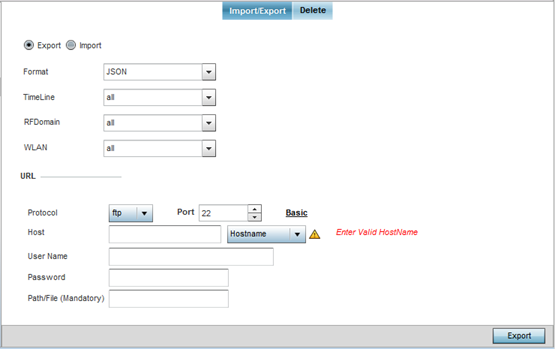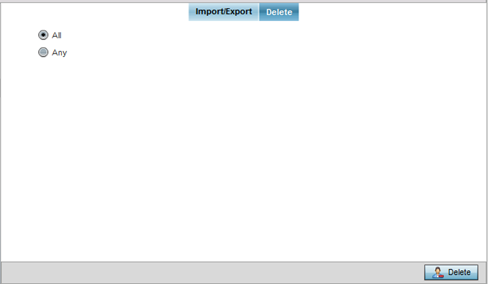Guest Access Database
About this task
Guest client statistics are uniquely available for wireless clients requesting the required pass code, authentication and access into the WiNG managed guest client network.
To administrate the guest access database:
Procedure
- Select the Statistics menu from the Web UI.
-
Select Guest Access above the
navigation pane (on the upper left-hand side of the screen, directly to the
right of System).
The Guest Access statistics menu is displayed in the right-hand pane, with the Statistics screen selected by default.
-
Select Database from the statistics
menu.
The Guest Access → Database page displays.
 Guest Access - Database - Import/Export Screen
Guest Access - Database - Import/Export Screen
- Select Export to archive guest access data (in JSON or CSV format) to a designated remote location, or Import to upload guest access utilization data back to the WiNG managed controller, service platform or access point.
-
If conducting an Export operation, provide the following to refine the data
exported:
Format Define whether the guest access data is exported in JSON or CSV format. JSON (JavaScript Object Notation ) is an open standard format using text to export data objects consisting of attribute value pairs. A CSV (comma-separated values ) file stores tabular data in plain text. Plain text means that the file is interpreted a sequence of characters, so that it is human-readable with a standard text editor. Each line of the file is a data record. Each record consists of one or more fields, separated by commas. Timeline Use the drop-down menu to specify whether guest access statistics are exported for the previous 1-Day, 1-Month, 1-Week, 2-Hours, 30-Mins or 5-Hours. Timelines support the latest time period from present. For example, specifying 30-Mins exports statistics trended over the most recent 30 minutes. RFDomain Use the drop-down menu to select a single RF Domain from which to filter social media guest access statistics. Optionally select All to include data from each RF Domain supported. WLAN Use the drop down menu to filter guest access social media statistics to a specific WLAN. Optionally select All to include data from all WLANs within the selected RF Domain. Note: A WLAN can belong to more then one RF Domain. -
When exporting or importing guest access data (regardless or format), provide
the following URL data to accurately configure the remote host.
Protocol Select the data transfer protocol used for exporting or importing guest access data. Available options include: - tftp
- ftp
- sftp
Port Use the spinner control to set the virtual port for the for the export or import operation. Host Provide a textual hostname or numeric IP address of the server used for guest access data transfer operations. Hostnames cannot include an underscore character. Select IPv4 Address to use an IPv4 formatted address as the host. Select IPv6 Address to use an IPv6 formatted address as the host. IPV6 provides enhanced identification and location information for computers on networks routing traffic across the Internet. IPv6 addresses are composed of eight groups of four hexadecimal digits separated by colons.
User Name If using FTP or SFTP as the data transfer protocol, enter the username required by the remote FTP or SFTP server resource. Password If using FTP or SFTP as the data transfer protocol, enter the password required by the remote FTP or SFTP server resource. Path/File (Mandatory) Specify the path to the server resource where guest access data is either exported or imported. Enter the complete relative path to the file on the server. If electing to use SFTP as the file transfer protocol, its recommended the path/file be set using the CLI (command line interface). - When the URL data is accurately entered, select the Export or Import button respectively to initiate the operation.
-
Optionally select the Delete tab to purge either all or
part of the guest user database.
The Guest Access → Database → Delete Screen displays.
 Guest Access - Database - Delete Screen
Guest Access - Database - Delete Screen
- Select All to remove the contents of the entire database. Select Any to invoke a drop-down menu where MAC, Name, Mobile, Email or a WLAN can be selected to refine the database removal to just a selected entity. Enter the name of the MAC address, user, mobile number or WLAN you wish to remove from the database, then select Delete.


